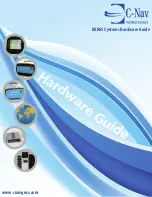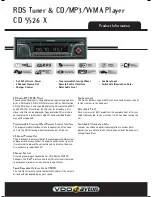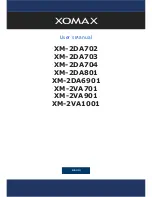
C-Nav Hardware Reference Guide
10
receiver near large reflecting surfaces. The first line of defense is to use the combination of
antenna cut-off angle and antenna location in order to minimize the problem. A second
approach is to utilize software algorithms within the receiver to minimize the impact of multipath
on range tracking accuracy. With proper location and antenna selection, the net impact to a
moving user should be less than 1 meter under most circumstances.
Receiver Errors
vary from GNSS unit to GNSS unit. Initially most commercial GPS receivers
were 'sequential', in that one or two tracking channels shared the burden of locking on to four or
more satellites. As chip technology improved, it was common to place three or more tracking
channels on a single chip. As the size and cost have decreased, techniques have improved and
'parallel' multi-channel receivers are common. Most modern GNSS receivers use an all-digital
design allowing very low signal noise and phase tracking solutions. This produces a precision of
better than 0.3 meter. Inter-channel bias is minimized with digital sampling and all-digital
designs. The net result is that survey-quality GNSS receivers now contribute less than 0.5-
meter error in bias and less than 0.2 meters in noise.
Measuring GNSS Accuracy
The fundamental and basic requirement of comparing geographic locations and coordinates is
that the reference coordinate system and datum transformation are known. The GPS system
functions within the Earth-Centered, Earth-Fixed World Geodetic System 1984 (WGS84)
ellipsoid and Cartesian coordinate system. GNSS receivers internally transform the Cartesian
data into degrees (Latitude and Longitude) with the vertical height expressed in meters above
the reference ellipsoid. Therefore, when comparing coordinate values for any location in the
world, such as a map position or feature, a physical survey marker or reference location, the
data and observations must be referenced to the same datum and coordinate system.
For example, in North America, there are two different datum models in common usage. These
are the North American Datum of 1927 (NAD27) and the North American Datum of 1983
(NAD83). A physical geographic feature on the surface will have entirely different coordinate
latitude and longitude values when expressed in each of the NAD-27 and NAD-83 datums.
The GNSS user is entirely responsible for understanding that a measured position using the
GNSS system (WGS84) requires transformation if the final coordinates are to be expressed in a
geodetic system other than WGS84. Ignorance of this fact will lead to significant errors in the
desired positional output and is often considered to be a result of the greatest source of error in
GNSS, human error.
Another major factor affecting an autonomous GNSS position is the GNSS Satellite position
geometry and visibility to the user, and a quality measure given by the Dilution of Precision
(DOP) indices provided by all GNSS receivers.
•
GDOP - Geometric Dilution of Precision
•
TDOP - Time Dilution of Precision
•
PDOP - Position Dilution of Precision
•
HDOP - Horizontal Dilution of Precision
•
VDOP - Vertical Dilution of Precision
Summary of Contents for 1000
Page 1: ...DGNSS Systems Hardware Guide www cnavgnss com ...
Page 20: ...C Nav Hardware Reference Guide 20 Figure 2 3 C Nav Antenna Mounting Pole Dimensions ...
Page 65: ...C Nav Hardware Reference Guide 65 Model No 3402 17 0070 Specifications ...
Page 67: ...C Nav Hardware Reference Guide 67 Huber Suhner Lightning Protector Mounting Instructions ...
Page 68: ...C Nav Hardware Reference Guide 68 ...
Page 69: ...C Nav Hardware Reference Guide 69 MOXA Converters TCC 80I TCC 80I Specifications ...
Page 72: ...C Nav Hardware Reference Guide 72 Times Microwave LMR400 Coaxial Cable LMR400 Specifications ...











































